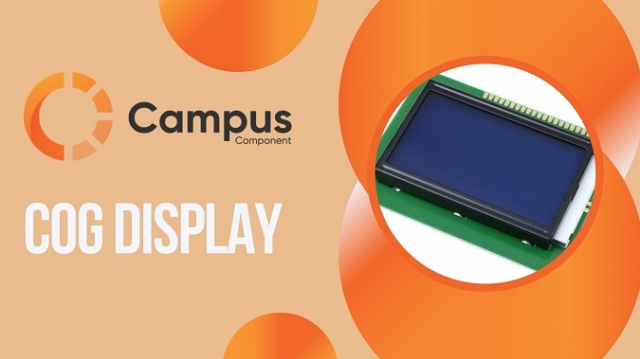Selecting the right LCD display technology for your electronic application is essential to ensure optimal performance. Two widely used assembly techniques in LCD modules are Chip-on-Glass (COG) and Chip-on-Board (COB). Each comes with unique benefits and is suited for different use cases.
In this comprehensive guide, we will explore the key distinctions between COG and COB LCD displays, helping you determine the best fit for your needs. As a reliable online supplier of electronic components, Campus Component offers a broad range of COG and COB LCD displays catering to both industrial and consumer applications.
What is a COG LCD Display?
Chip-on-Glass (COG) LCD technology integrates the driver IC directly onto the glass substrate of the display panel. This innovative design results in a sleek and lightweight display module, making it highly suitable for modern, compact electronic devices.
Key Benefits of COG LCD Displays:
- Slim & Lightweight Design
Since the IC is mounted directly on the glass, the module maintains a low-profile structure, making it ideal for handheld and portable devices.
- Energy Efficient
COG LCDs are designed to consume minimal power, making them an excellent choice for battery-operated gadgets.
- Enhanced Reliability
With fewer interconnections and components, COG displays are less prone to mechanical failures.
- Superior Visual Clarity
These displays typically offer high contrast and sharp image quality, ensuring a better viewing experience.
Common Applications of COG LCD Displays:
- Medical and diagnostic equipment
- Industrial control panels
- Automotive instrument clusters
- Handheld communication and consumer electronics
What is a COB LCD Display?
Chip-on-Board (COB) LCD technology involves mounting the driver IC onto a printed circuit board (PCB), which is then connected to the LCD module. This conventional assembly method is widely used in applications requiring larger displays and robust durability.
Advantages of COB LCD Displays:
- Simplified Integration
The PCB provides multiple connectivity options, making it easier to integrate into various designs. - Highly Durable
The assembly is built to withstand mechanical stress, making it ideal for rugged industrial environments. - Effective Heat Dissipation
The PCB allows better heat management, enhancing long-term reliability. - Supports Larger Display Sizes
COB displays are well-suited for bigger LCD panels, where direct glass integration is impractical.
Common Applications of COB LCD Displays:
- ATM machines and banking terminals
- Industrial automation and machinery
- Point-of-sale (POS) systems
- Household appliances and smart home devices
COG vs. COB LCD Displays: Feature Comparison
|
Feature |
COG LCD Display |
COB LCD Display |
|
Design & Size |
Slim and compact |
Bulkier due to PCB |
|
Power Consumption |
Low power usage |
Slightly higher power usage |
|
Reliability |
Fewer components, more reliable |
More durable but additional failure points |
|
Heat Dissipation |
Moderate, design-dependent |
Superior heat management |
|
Cost |
Higher due to advanced technology |
More budget-friendly |
|
Best Suited For |
Small, high-performance devices |
Large, industrial-grade applications |
Which One Should You Choose?
Opt for a COG LCD Display if:
- You need a lightweight and compact display module.
- Your project requires low power consumption for better efficiency.
- High contrast and sharpness are essential.
- Your application is in medical, automotive, or portable electronics.
Go for a COB LCD Display if:
- You need a sturdy and impact-resistant display solution.
- The display will face mechanical stress or industrial usage.
- Larger display sizes with multiple connectivity options are required.
- Your design allows for PCB-based assembly.
Where to Buy High-Quality COG and COB LCD Displays?
If you're looking for premium COG and COB LCD displays, Campus Component provides a diverse selection of high-performance LCD modules suited for different industries. One notable option is the Sinda COG White LCD Display, known for its high contrast, low power consumption, and durability, making it an excellent choice for various applications.
Final Thoughts
Both COG and COB LCD displays offer distinct advantages, and the choice depends on the specific requirements of your project. If you need a compact, power-efficient display, COG is the way to go. However, if ruggedness and versatility are more critical, COB is the better alternative.
Whatever your LCD display needs, Campus Component is your go-to source for top-quality LCD and LED solutions. Browse our collection today and find the perfect display for your next project!






